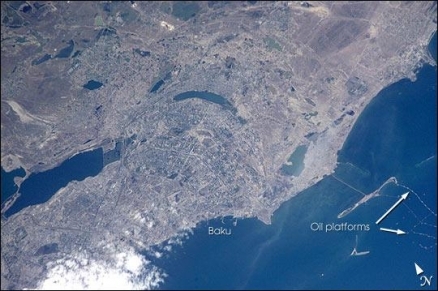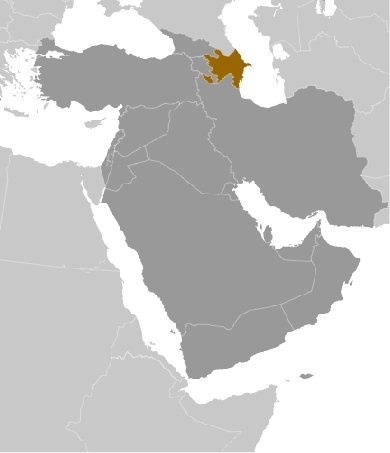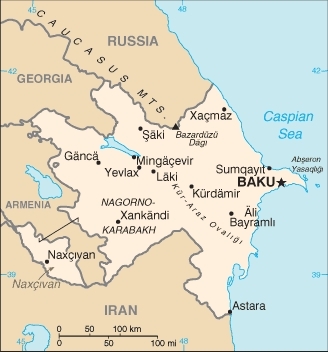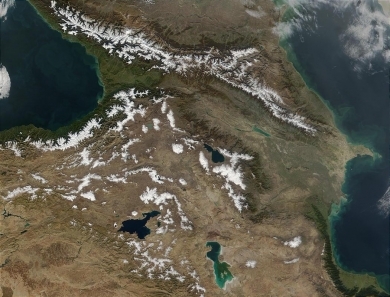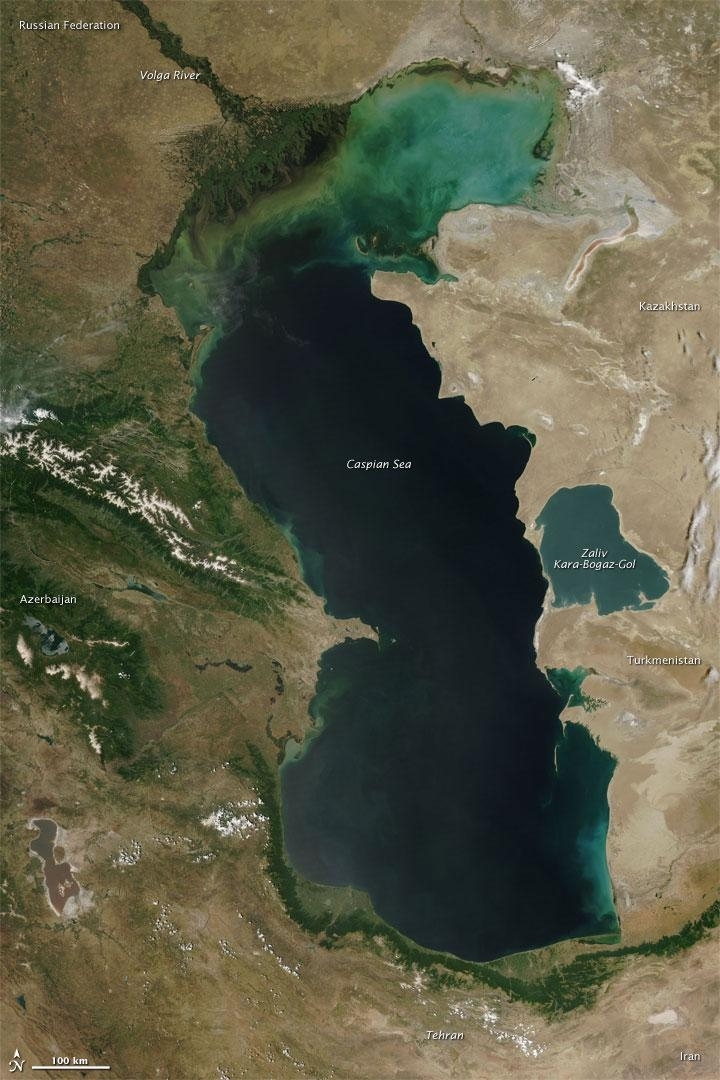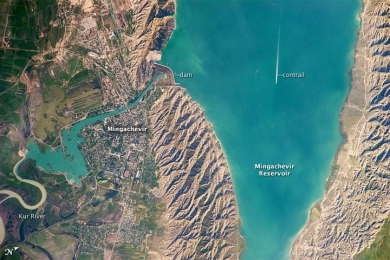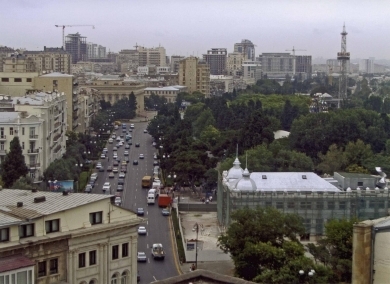Azerbaijan (About the EoE)
Contents
Azerbaijan
Countries and Regions of the World Collection  Azerbaijan is a landlocked nation of nine-and-a-half million people that strddles the Caucasus mountain range separating southwestern Asia from Europe.
Azerbaijan is a landlocked nation of nine-and-a-half million people that strddles the Caucasus mountain range separating southwestern Asia from Europe.
It lies between Iran to its south and Russia and Georgia to the north, with the Caspian Sea to the east and Armenia to the west.
Azerbaijan is divided into two portions; a main area east of Armenia and west of the Caspian Sea; and, the Nagorno-Karabakh region, west of Armenia.
Local scientists consider the Abseron Yasaqligi (Apsheron Peninsula) (including Baku and Sumqayit) and the Caspian Sea to be the ecologically most devastated area in the world because of severe air, soil, and water pollution; soil pollution results from oil spills, from the use of DDT pesticide, and from toxic defoliants used in the production of cotton. Azerbaijan is susceptible to droughts.
Azerbaijan combines the heritage of two venerable civilizations--the Seljuk Turks of the 11th century and the ancient Persians. Its name is thought to be derived from the Persian phrase "Land of Fire," referring both to its petroleum deposits, known since ancient times, and to its status as a former center of the Zoroastrian faith. The Azerbaijani Republic borders the Iranian provinces of East and West Azerbaijan, which are predominantly populated by ethnic Azeris.
Azerbaijan - a nation with a majority-Turkic and majority-Muslim population - was briefly independent from 1918 to 1920; it regained its independence after the collapse of the Soviet Union in 1991. Residents have evacuated the former Soviet-era small ethnic enclaves in Armenia and Azerbaijan.
Despite a 1994 cease-fire, Azerbaijan has yet to resolve its conflict with Armenia over Nagorno-Karabakh, a primarily Armenian-populated region that Moscow recognized as part of Soviet Azerbaijan in the 1920s after Armenia and Azerbaijan disputed the status of the territory. Armenia and Azerbaijan began fighting over the area in 1988; the struggle escalated after both countries attained independence from the Soviet Union in 1991. By May 1994, when a cease-fire took hold, ethnic Armenian forces held not only Nagorno-Karabakh but also seven surrounding provinces in the territory of Azerbaijan. The dispute over the break-away Nagorno-Karabakh region and the Armenian military occupation of surrounding lands in Azerbaijan remains the primary focus of regional instability.
Corruption in the country is ubiquitous, and the government, which eliminated presidential term limits in a 2009 referendum, has been accused of authoritarianism.
Although the poverty rate has been reduced in recent years due to revenue from oil production, the promise of widespread wealth resulting from the continued development of Azerbaijan's energy sector remains largely unfulfilled.
Azerbaijan,Kazakhstan, and Russia ratified Caspian seabed delimitation treaties based on equidistance, while Iran continues to insist on a one-fifth slice of the lake.
Bilateral talks continue with Turkmenistan on dividing the seabed and contested oilfields in the middle of the Caspian
Local border forces struggle to control the illegal transit of goods and people across the porous, undemarcated Armenian, Azerbaijani, and Georgian borders.
Geography
Location: Southwestern Asia, bordering the Caspian Sea, between Iran and Russia, with a small European portion north of the Caucasus range
Geographic Coordinates: 40 30 N, 47 30 E
Area: 86,600 sq km (land: 82,629 sq km;water: 3,971 sq km). This includes the exclave of Naxcivan Autonomous Republic and the Nagorno-Karabakh region; the region's autonomy was abolished by Azerbaijani Supreme Soviet on 26 November 1991.
Land Boundaries: 2,013 km (Armenia (with Azerbaijan-proper) 566 km, Armenia (with Azerbaijan-Naxcivan exclave) 221 km, Georgia 322 km, Iran (with Azerbaijan-proper) 432 km, Iran (with Azerbaijan-Naxcivan exclave) 179 km, Russia 284 km, Turkey 9 km
Coastline: 0 km (landlocked); note - Azerbaijan borders the Caspian Sea (713 km)
Natural Hazards: droughts.
Terrain: large, flat Kur-Araz Ovaligi (Kura-Araks Lowland) (much of it below sea level) with Great Caucasus Mountains to the north, Qarabag Yaylasi (Karabakh Upland) in west; Baku lies on Abseron Yasaqligi (Apsheron Peninsula) that juts into Caspian Sea. The highest point is Bazarduzu Dagi (4,485 m) and the lowest point is the Caspian Sea (-28 m)
Climate: dry, semiarid steppe
Ecology and Biodiversity
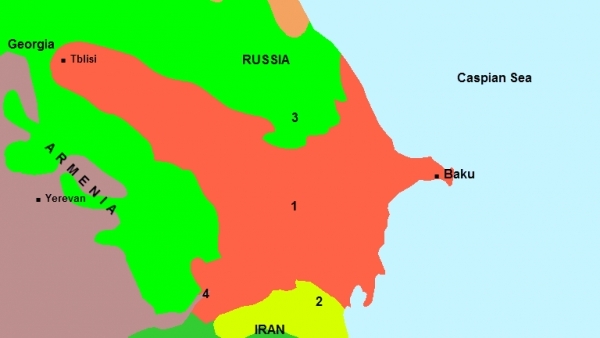
Ecoregions of Azerbaijan. Source: World Wildlife Fund
See also:
|
|
| Often regarded as the southeastern border of Europe, the Caucasus Mts stretch from the Black Sea (left) to the Caspian Sea (right). The mountain range spans 1,125 km (700 mi), forming part of the southern Russian border, and crossing Georgia, Armenia, and Azerbaijan from left to right respectively. With a snowline of approximately 3,350 m (11,000 ft) and many peaks over 4,500 m (14,760 ft), much of the snow seen in this image is present year round. Also visible in this photo are apparent phytoplankton blooms in the Caspian Sea, marked by blue-green swirls. Image credit: NASA. |
| Measured by surface area, the Caspian Sea is the world's largest inland water body. It covers roughly 371,000 sq km (143,200 sq mi) and borders five countries. To the ancient Greeks and Persians, the lake's immense size suggested it was an ocean, hence its name. A large expanse of clear sky permitted this natural-color satellite image of the entire water body. The color of the Caspian Sea darkens from north to south, thanks to changes in depth and perhaps sediment and other runoff. The northern part of the lake is just 5 to 6 m (16 to 20 ft) deep. The southern end, however, plunges more than 1,000 m (3,300 ft). Just as the lake reaches a greater depth in the south, the nearby land reaches a greater height. The mountains of northern Iran line the southern end of the giant lake, and emerald green vegetation clings to those mountain slopes. In marked contrast to the mountains, sand seas line the southeastern and northern perimeters of the lake, and marshes occur along the lake shores in Azerbaijan to the west. Multiple rivers empty into the Caspian Sea, the Volga being the largest. Lacking an outlet, the Caspian Sea loses water only by evaporation, leading to the accumulation of salt. Although a lake, the Caspian is not a freshwater lake; the water delivered by the Volga River minimizes the lake's salt content at the northern end, but the Caspian grows more saline to the south. Kara-Bogaz-Gol is a saline inlet along the lake's eastern perimeter. Image courtesy of NASA. |
| This astronaut photograph highlights the southern Mingachevir Reservoir in north-central Azerbaijan. The Mingachevir Reservoir occupies part of the Kura Basin, a topographic depression located between the Greater Caucasus Mountains to the northeast and the Lesser Caucasus Mountains to the southwest. The afternoon sun highlights distinctive parallel patterns in the hills that are the result of water and wind erosion of different rock layers exposed at the surface. The nearby city of Mingachevir (left) is split by the Kur River after it passes through the dam and hydroelectric power station complex at image top center. The current city was built in support of the hydroelectric power station constructed as part of the then-Soviet Union's energy infrastructure for the region. Today, Mingachevir is the fourth-largest city in Azerbaijan (by population), and it has become a cultural and economic center of the country. The width of the reservoir illustrated here is approximately 8 km (5 mi); a jet flying over the reservoir left a contrail midway between the shorelines. Photo courtesy of NASA. |
| A downtown view of the capital of Baku. |
People and Society
Population: 9,493,600 (July 2012 est.)
Ethnic groups: Azeri 90.6%, Dagestani 2.2%, Russian 1.8%, Armenian 1.5%, other 3.9% (1999 census). Note:almost all Armenians live in the separatist Nagorno-Karabakh region
Age Structure:
0-14 years: 23.2% (male 1,029,931/female 912,639)
15-64 years: 70.3% (male 2,896,785/female 2,993,092)
65 years and over: 6.4% (male 195,853/female 344,073) (2011 est.)
Population Growth Rate: 1.017% (2012 est.)
Birthrate: 17.3 births/1,000 population (2012 est.)
Death Rate: 7.13 deaths/1,000 population (July 2012 est.)
Net Migration Rate: 0 migrant(s)/1,000 population (2012 est.)
Life Expectancy at Birth: 28.76 deaths/1,000 live birth
male: 29.48 deaths/1,000 live births
female: 27.93 deaths/1,000 live births (2012 est.)
Total Fertility Rate: 1.92 children born/woman (2012 est.)
Languages: Azerbaijani (Azeri) (official) 90.3%, Lezgi 2.2%, Russian 1.8%, Armenian 1.5%, other 3.3%, unspecified 1% (1999 census)
Literacy (age 15 and over can read and write): 98.8%
Urbanization: 52% of total population (2010) growing at an annual rate of change of 1.4% (2010-15 est.)
History
Little is known about Azerbaijan's history until its conquest and conversion to Islam by the Arabs in 642 AD. Centuries of prosperity as a province of the Muslim caliphate followed. After the decline of the Arab Empire, Azerbaijan was ravaged during the Mongol invasions but regained prosperity in the 13th-15th centuries under the Mongol II-Khans, the native Shirvan Shahs, and under Persia's Safavid Dynasty.
Due to its location on the shore of the Caspian Sea and astride the trade routes connecting Europe to Central Asia and the Near East, Azerbaijan was fought over by Russia, Persia, and the Ottomans. Finally, the Russians split Azerbaijan's territory with Persia in 1828 by the Treaty of Turkmenchay, establishing the present frontiers and extinguishing the last native dynasties of local Azerbaijani khans. The beginning of modern exploitation of the oil fields in the 1870s led to a period of unprecedented prosperity and growth in the years before World War I.
Following the collapse of the Russian Empire in 1917, an independent republic was proclaimed in 1918 after an abortive attempt to establish a Transcaucasian Republic with Armenia and Georgia. The first democratic republic in the Muslim world, it gave women the right to vote in 1919. Azerbaijan received de facto recognition by the Allies as an independent nation in January 1920, an independence terminated by the arrival of the Red Army in April. Incorporated into the Transcaucasian Federated Soviet Socialist Republic in 1922, Azerbaijan became a union republic of the U.S.S.R. (Soviet Union) in 1936. The late 1980s were characterized by increasing unrest, eventually leading to a violent confrontation when Soviet troops killed 190 nationalist demonstrators in Baku on January 19-20, 1990. Azerbaijan declared its independence from the U.S.S.R. on August 30, 1991, with Ayaz Mutalibov, former First Secretary of the Azerbaijani Communist Party, becoming the country's first President. Following a March 1992 massacre of Azerbaijanis at Khojali in Nagorno-Karabakh (a predominantly ethnic Armenian region within Azerbaijan), Mutalibov resigned and the country experienced a period of political instability. The old guard returned Mutalibov to power in May 1992, but less than a week later his efforts to suspend a scheduled presidential election and ban all political activity prompted the opposition Popular Front Party (PFP) to organize a resistance movement and take power. Among its reforms, the PFP dissolved the predominantly Communist Supreme Soviet and transferred its functions to the 50-member National Council.
Elections in June 1992 resulted in the selection of PFP leader Abulfez Elchibey as the country's second President. The PFP-dominated government, however, proved incapable of either credibly prosecuting the Nagorno-Karabakh conflict or managing the economy, and many PFP officials came to be perceived as corrupt and incompetent. Growing discontent culminated in June 1993 in an armed insurrection in Ganja, Azerbaijan's second-largest city. As the rebels advanced virtually unopposed on Baku, President Elchibey fled to his native province, the Azerbaijani exclave of Nakhchivan. The National Council conferred presidential powers upon its new Speaker, Heydar Aliyev, former First Secretary of the Azerbaijani Communist Party (1969-81) and member of the U.S.S.R. Politburo and U.S.S.R. Deputy Prime Minister (until 1987). Elchibey was formally deposed by a national referendum in August 1993, and Aliyev was elected to a 5-year term as President in October with only token opposition. Aliyev won re-election to another 5-year term in 1998, in an election marred by serious irregularities. A presidential election that took place on October 15, 2003 resulted in the election of Ilham Aliyev, the son of Heydar Aliyev. The election did not meet international standards. Ilham Aliyev assumed the office of president on October 31, 2003. Heydar Aliyev died December 12, 2003.
Ilham Aliyev won re-election on October 15, 2008, taking 88.7% of the vote in an election boycotted by the major opposition parties. While the presidential election marked progress toward meeting Organization for Security and Cooperation in Europe (OSCE) commitments and other international standards with regard to some technical aspects of election administration, the election process failed to meet some OSCE standards, according to the final report of the OSCE/Office for Democratic Institutions and Human Rights (ODIHR) election monitoring mission. In December 2008, the Azerbaijani parliament approved a measure calling for the abolition of presidential term limits. After limited public debate, the measure passed in a March 18, 2009 referendum on constitutional amendments. Observers noted serious shortcomings in voting procedures, and in the counting and tabulation process.
Azerbaijan's first parliament was elected in 1995. The present 125-member unicameral parliament was elected in November 2010 in an election that did not meet a number of international standards. 70 elected parliamentarians are from the President's New Azerbaijan Party, 10 are from various other political parties that largely support the President, and 42 claim no party affiliation, but consistently vote with the ruling party. Traditional opposition parties Musavat and the Popular Front are not represented in parliament. The November 2010 parliamentary elections were marred by a deficient candidate registration process, limits on freedom of assembly and expression, a restrictive political environment, unbalanced media coverage of candidates, and problems in vote counting and tabulation. Under the 1995 constitution, the speaker of parliament stands next in line to the President. However, constitutional amendments approved in a flawed process in August 2002 included a provision replacing the speaker of parliament with the prime minister in the line of succession to the presidency. The parliament remains a weak body with little real influence that votes nearly unanimously on all the executive government’s initiatives.
The human rights situation in the country remains poor, especially with respect to freedom of assembly, freedom of expression, the administration of justice, and the respect of property rights. In 2011, several political protests calling for democratic reform and the government's resignation were forcefully dispersed and 15 protesters were sentenced to 18 months to three years of incarceration for their participation in such protests. Applications to hold protests in Baku were repeatedly denied throughout the year. Local NGOs have reported forced evictions on dubious eminent domain grounds, inadequate compensation, and unclear property registration regulations. Restrictions on the freedom of religion also remain a problem. Corruption remains pervasive in all aspects of society.
Government
Although the Government of Azerbaijan consists of three branches, Azerbaijan has a strong presidential system in which the president dominates the legislative and judicial branches. The executive branch is made up of a president, his administration, a prime minister, and the cabinet of ministers. The legislative branch consists of the 125-member parliament (Milli Majlis). Members, all of whom are elected from territorial districts, serve 5-year terms. The judicial branch, headed by a Constitutional Court, is only nominally independent.
Government Type: Republic
Capital: Baku (population: 1.95 million estimated in 2009)
Administrative Divisions: 59 rayons (rayonlar; rayon - singular), 11 cities (saharlar; sahar - singular), 1 autonomous republic (muxtar respublika)
Independence Date: 30 August 1991 (declared from the Soviet Union); 18 October 1991 (adopted by the Supreme Council of Azerbaijan)
Legal System: civil law system. Azerbaijan has not submitted an International Court of Justice (ICJ) jurisdiction declaration and is a non-party state to the International Criminal Court (ICCt)
Environmental Issues
Azerbaijan faces serious environmental challenges. Soil throughout the region was contaminated by DDT and toxic defoliants used in cotton production during the Soviet era. Caspian petroleum and petrochemicals industries also have contributed to present air and water pollution problems. Several environmental organizations exist in Azerbaijan, yet few funds have been allocated to begin the necessary cleanup and prevention programs. Over-fishing by poachers is threatening the survival of Caspian sturgeon stocks, the source of most of the world's supply of caviar. The Convention on International Trade in Endangered Species (CITES) has listed as threatened all sturgeon species, including all commercial Caspian varieties. CITES imposed a ban on most Caspian caviar in January 2006, but lifted the ban a year later in favor of quotas. A March 2010 CITES conference labeled Caspian beluga sturgeon as 'critically endangered,' but as of yet no changes have been made to current sturgeon fishing quotas.
International Environmental Agreements
Azerbaijan is party to international agreements on Air Pollution, Biodiversity, Climate Change, Climate Change-Kyoto Protocol, Desertification, Endangered Species, Hazardous Wastes, Marine Dumping, Ozone Layer Protection, Ship Pollution, and Wetlands.
Water
Total Renewable Water Resources: 30.3 cu km (1997)
Freshwater Withdrawal: 17.25 cu km/yr (5% domestic, 28% industrial, 68% agricultural)
Per capita freshwater withdrawal: 2,051 cu m/yr (2000)
Access to improved drinking water sources: 80% of population
Access to improved sanitation facilities: 45% of population
See: Water profile of Azerbaijan
Agriculture
Agricultural products: cotton, grain, rice, grapes, fruit, vegetables, tea, tobacco; cattle, pigs, sheep, goats
Irrigated Land: 14,300 sq km (2008)
Resources
Azerbaijan is considered one of the most important spots in the world for oil exploration and development. Proven oil reserves in the Caspian Basin, which Azerbaijan shares with Russia, Kazakhstan, Turkmenistan, and Iran, are comparable in size to North Sea reserves several decades ago.
Azerbaijan's oil production increased dramatically in 1997, when Azerbaijan signed the first production-sharing arrangement (PSA) with the Azerbaijan International Operating Company. The Baku-Tbilisi-Ceyhan (BTC) pipeline, which opened in May 2005, has a maximum capacity of one million barrels per day.
While oil and gas production in Azerbaijan has been steady for the past few years, imminent large-scale investments in the oil and gas sector (most notably, a $20 billion investment for the second stage of the Shah Deniz gas project) are likely to cause energy production to climb over the next decade. Negotiations are ongoing over different gas pipeline options for transporting Caspian gas to Southern Europe.
Oil exports through the Baku-Tbilisi-Ceyhan Pipeline remain the main economic driver while efforts to boost Azerbaijan's gas production are underway. However, Azerbaijan has made only limited progress on instituting market-based economic reforms.
Natural Resources: petroleum, natural gas, iron ore, nonferrous metals, bauxite
See:
- Energy profile of Azerbaijan
- Energy profile of the Caspian Sea region
- Energy profile of the Caucasus region
Land Use:
Economy
Over the past few years, the Government of Azerbaijan has worked to integrate the country into the global economic marketplace, attract increased foreign investment, diversify its economy, and maintain positive growth during the global financial crisis.
Wide-ranging economic reforms implemented by Azerbaijan during the past five years have resulted in notable progress to improve regulatory efficiency and encourage domestic economic diversification, especially in the areas of agriculture, tourism, and information and communications technology. In particular, the substantial economic reforms implemented in 2007 and 2008 led the World Bank to name Azerbaijan as one of the top ten global reformers for 2009 in its annual Doing Business report. Azerbaijan has enjoyed measurable success in diversifying its economy outside of the energy sector, with the non-oil portion of the economy growing by almost ten percent in 2011, while energy sector growth was flat.
In the past few years, the overall regulatory reform process has slowed in comparison to 2007-2009. While many of the reforms adopted were designed to facilitate Azerbaijan’s accession to the World Trade Organization (WTO), as of March 2012, Azerbaijan still is not a WTO member.
Azerbaijan has a liberal exchange rate system and, in general, there are no restrictions on converting or transferring funds associated with an investment into freely usable currency at a legal market-clearing rate. No systematic difficulties exist in obtaining foreign exchange. The official currency reserves of the Central Bank of Azerbaijan, previously the National Bank of Azerbaijan, increased from 6.4 billion USD at the end of 2010 to 10.48 billion USD at the beginning of 2012. Reserves had decreased in 2009 primarily in response to the global financial crisis, which facilitated a decline in hard-currency reserves in Azerbaijan’s commercial banks, prompting the Central Bank of Azerbaijan to expend reserves to maintain the convertibility rate of the Azerbaijani Manat in direct support of the Azerbaijani economy. The average annual inflation rate for 2011 was 8.1 percent (EIU). In March 2011, the Central Bank increased its interest rate to avoid inflation; however, in late 2011, the Central Bank urged commercial banks to decrease their interest rates in order to stimulate non-oil sector growth.
In December 2011, Standard & Poor’s upgraded the sovereign credit rating of Azerbaijan to BBB- investment grade and concluded that the rating had a stable outlook. Fitch Ratings affirmed the long-term sovereign rating of investment in foreign and domestic currency for Azerbaijan at BBB- and upgraded the outlook for Azerbaijan from stable to positive in September 2011. Fitch Ratings first assigned Azerbaijan the BBB- rating in May 2010. Additionally, Moody’s Investor Service upgraded the outlook on Azerbaijan’s sovereign rating from stable to positive and confirmed the issuer rating for government debt at Ba1 in March 2011.
The State Oil Fund (SOFAZ) – with assets totaling 29.8 billion USD in reserves at the end of 2011 – operates as a sovereign wealth fund for Azerbaijan. It was established in 1999 and reports directly to the President of Azerbaijan through its Executive Director. SOFAZ manages all state revenue from oil and natural gas, and is charged with preserving Azerbaijan’s economic stability, helping diversify the economy, and preserving the nation’s wealth for future generations.
Importantly, the higher inflation also reflects customs restrictions that are in place due to supply constraints that limit import competition and to monopolies that continue to control many sectors of the economy. The national currency, the Manat (AZN), is artificially stable and was allowed to appreciate against the dollar by 6.1% in 2005, 5.4% in 2006, 3.4% in 2007, and 1.1% in 2008. By early 2009, one AZN was worth $1.24, an exchange rate that has remained steady ever since, increasing only slightly since late 2010.
The 2012 consolidated state budget sets spending at 17.1 billion AZN, an increase of about 5% over 2011. The budget funds an ambitious program of infrastructure investments, focusing on transportation and water and irrigation. About three-quarters of the budget is funded by transfers from SOFAZ and taxes on oil companies. This degree of reliance on hydrocarbon revenues has led the IMF to express concerns about the economy’s stability and vulnerability to inflationary pressures. While a significant drop in oil prices would likely require some curtailment of the government’s investment program, to date, inflationary pressures have been manageable.
Despite substantial progress in stabilizing the economy and reducing poverty over the past few years, substantial medium-to-long term economic challenges for Azerbaijan still remain, particularly with regards to the implementation of institutional and systemic reforms that are critical to strengthening the foundations for economic freedom. Although Azerbaijan has continued to attract significant foreign investment to further develop its energy sector throughout the past decade, inefficient government bureaucracy, weak legal institutions, requests for illicit payments for cross-border transactions, and predatory behavior by politically connected monopolistic interests continue to hinder investment outside of this sector and present challenges for foreign investors.
Azerbaijan's high economic growth during 2006-08 was attributable to large and growing oil exports, but some non-export sectors also featured double-digit growth, spurred by growth in the construction, banking, and real estate sectors. In 2009, economic growth remained above 9% even as oil prices moderated and growth in the construction sector cooled. In 2010, economic growth slowed to 3.7%, although the impact of the global financial crisis was less severe than in many other countries in the region.
The current global economic slowdown presents some challenges for the Azerbaijani economy as oil prices remain below their mid-2008 highs, highlighting Azerbaijan's reliance on energy exports and lackluster attempts to diversify its economy.
Pervasive public and private sector corruption and structural economic inefficiencies remain a drag on long-term growth, particularly in non-energy sectors.
Several other obstacles impede Azerbaijan's economic progress: the need for stepped up foreign investment in the non-energy sector and the continuing conflict with Armenia over the Nagorno-Karabakh region.
Trade with Russia and the other former Soviet republics is declining in importance, while trade is building with Turkey and the nations of Europe.
Long-term prospects depend on world oil prices, the location of new oil and gas pipelines in the region, Azerbaijan's ability to negotiate export routes for its growing gas production, and its ability to manage its energy wealth to promote growth and spur employment in non-energy sectors of the economy.
GDP: (Purchasing Power Parity): $93.02 billion (2011 est.)
GDP: (Official Exchange Rate): $68.5 billion (2011 est.)
GDP- per capita (PPP): $10,200 (2011 est.)
GDP- composition by sector:
agriculture: 5.5%
industry: 62.7%
services: 31.8% (2011 est.)
Industries: petroleum and natural gas, petroleum products, oilfield equipment; steel, iron ore; cement; chemicals and petrochemicals; textiles
Currency: Azerbaijani manats (AZN)
